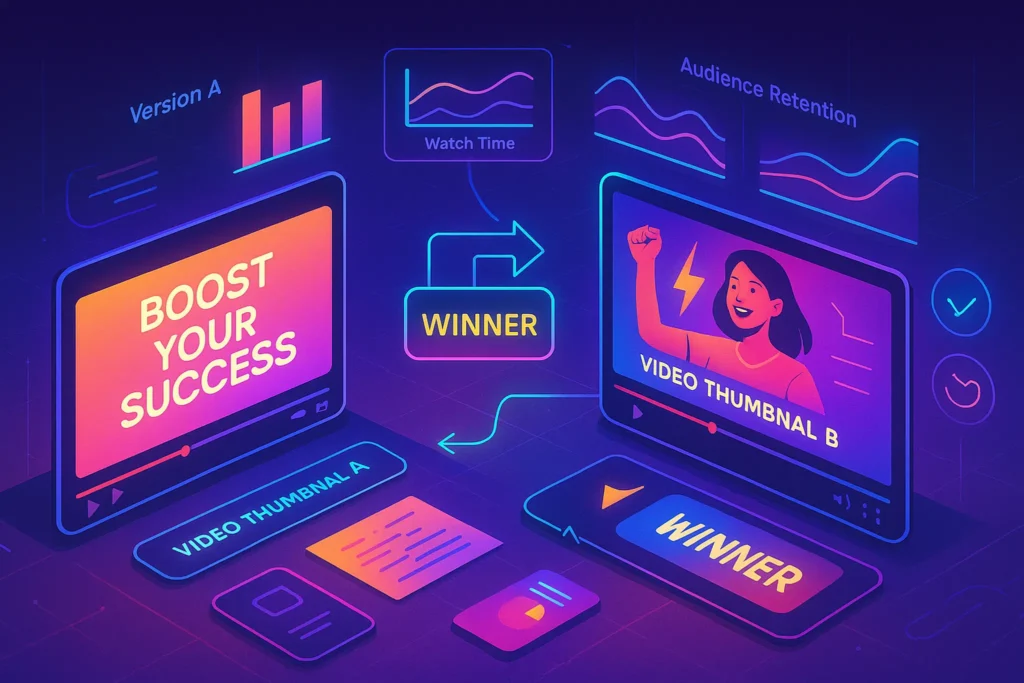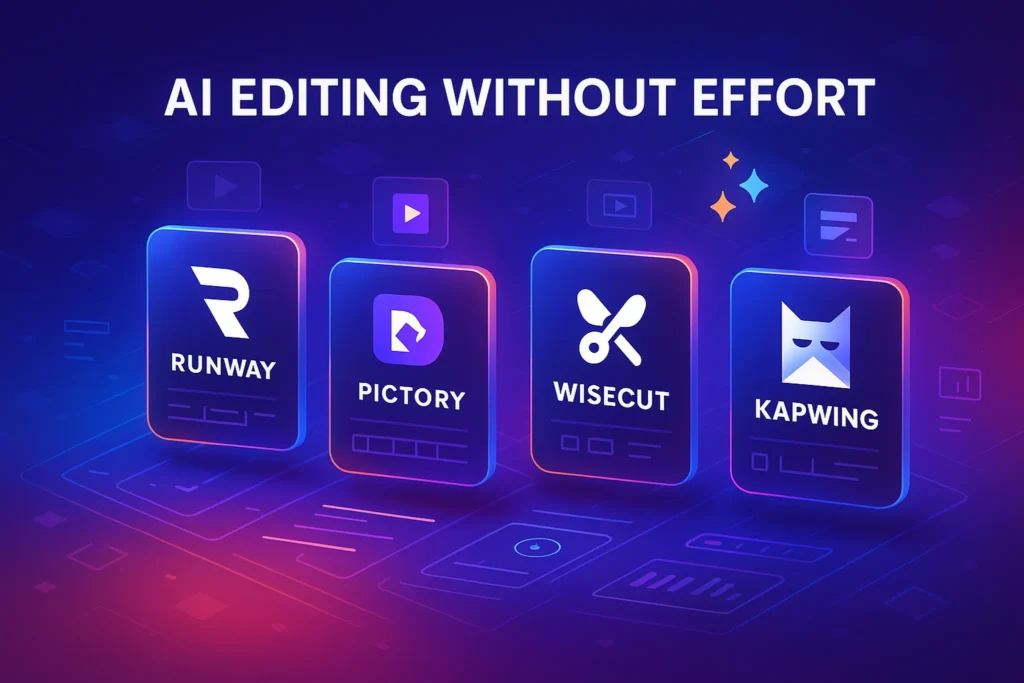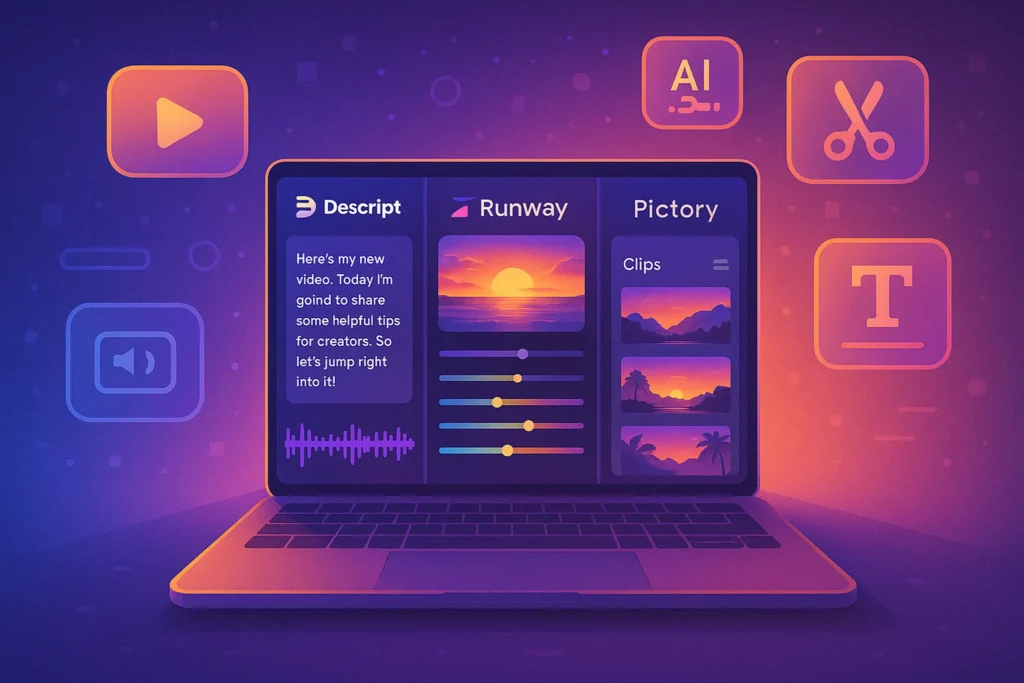🎬 Why A/B Testing is a Game-Changer for Video Marketing
Even the most creative video idea can underperform if small but crucial details — like the thumbnail, title, or pacing — miss the mark. That’s where A/B testing becomes your secret weapon. By running controlled experiments on different elements of your videos, you’re not guessing what works — you’re proving it with data.
When done right, A/B testing can lead to:
-
Higher click-through rates (CTR)
-
Longer average watch times
-
Better engagement (likes, comments, shares)
-
Higher conversions for calls-to-action
💬 Think of it like fine-tuning a high-performance car — the video is your engine, but testing optimizes the fuel, tires, and aerodynamics.
In a world where platforms like YouTube and TikTok decide your reach based on early engagement, data-backed decisions can be the difference between a video that dies in 48 hours and one that trends for weeks.
Platforms update algorithms and viewer behavior every quarter; what earns clicks this year may fall flat next season. To keep your testing calendar aligned with real shifts—like changes in Shorts watch-time or CTR boosts from auto-captions—our Video Marketing Trends breakdown helps you design hypotheses based on current realities, not outdated assumptions.
🧠 Core Principles of A/B Testing for Video Content
Before you start, remember: A/B testing is about isolating one variable at a time. If you change your title and thumbnail simultaneously, you won’t know which made the difference.
Key Principles:
-
Change One Thing at a Time
If you’re testing thumbnails, keep titles and descriptions identical. -
Run Tests for Enough Time
On YouTube, a good test period is 7–14 days for accurate CTR and watch time data. -
Measure with the Right Metrics
-
CTR for thumbnails and titles
-
Average view duration for pacing and length tests
-
Conversion rate for end screens or CTAs
-
-
Repeat and Iterate
One winning test is just the beginning. Continue testing regularly.
💬 Nerd Tip: The YouTube Analytics “Compare to” feature is your best friend for spotting changes in performance.
🎯 What You Can Test in Your Video Marketing
Here’s where the magic happens — specific elements you can test to improve your videos.
1. Thumbnails
Thumbnails are the billboards of your videos. A bright, high-contrast design with a clear focal point can double your CTR.
Example: In a case study by TubeBuddy, changing a thumbnail to one with a close-up face increased CTR from 4.2% to 7.8% in just 10 days.
✅ Test ideas:
-
Close-up faces vs. no faces
-
Text overlay vs. clean image
-
Bright background vs. muted tones
2. Titles
Titles drive curiosity and relevance. A/B testing your titles can reveal whether your audience responds better to curiosity-driven hooks or clear benefit statements.
Example:
-
Version A: How to Script Your Videos for Maximum Engagement
-
Version B: This Video Script Hack Tripled My Watch Time
📌 Tools like TubeBuddy A/B Testing make this process effortless.
3.⏱️ Video Length
Video length is one of the most underestimated variables in video performance. Too short, and you may not provide enough value. Too long, and you risk losing attention. The “ideal” length often depends on the platform and audience intent.
-
Short-form platforms (TikTok, Reels, Shorts) thrive on bite-sized content — think 15–45 seconds for maximum watch-through rates.
-
Long-form platforms like YouTube can reward depth, with 8–12 minutes being a sweet spot for ad monetization and in-depth storytelling.
When A/B testing video length, keep all other variables constant — same topic, same editing style, same intro — so you can accurately measure whether a shorter or longer format impacts metrics like watch time, engagement rate, or conversion.
💡 Nerd Tip: Use audience retention graphs in tools like YouTube Analytics to identify drop-off points. This will tell you if your videos should be trimmed or expanded.
💬 Nerd Tip: Don’t cut value to shorten a video — trim filler instead.
4. 🎬 Hooks and Intros
The first 15 seconds are critical. Test different opening styles: a teaser clip, a direct question, or a fast benefit statement.
Your hook — the first 3–10 seconds — determines whether viewers will commit or swipe away. Even a perfectly produced video will fail if the intro doesn’t grab attention.
Hooks can be tested in various forms:
-
Question-based hooks: “What if I told you you’re editing your videos all wrong?”
-
Bold statement hooks: “This one thumbnail change doubled my YouTube income.”
-
Pattern interruption hooks: Unusual visuals or sound effects that break scrolling monotony.
A/B testing hooks means creating two versions of the same video with different openings and tracking audience retention in the first 30 seconds. You may find that one style gets more initial attention, while another sustains better retention.
💬 “Treat your first 5 seconds like a movie trailer for your video — make them impossible to skip.”
When you’re analyzing the results of your thumbnail and hook tests, remember that virality often comes from repeatable patterns: visual shock, relatability, and an instant promise of value. If you want to systematically integrate these patterns into your A/B tests—from building emotional hooks to fine-tuning editing rhythm—our guide How to Create Viral Video Content gives you a formula so you’re relying on strategy, not luck.
5. 📍 Call-to-Action Placement
Experiment with CTAs at the start, middle, or end. Data from Wistia shows CTAs in the middle of videos often convert better for engaged viewers.
A call-to-action (CTA) tells your viewers what to do next — subscribe, comment, click a link, or buy a product. But when you deliver the CTA can be as important as the message itself.
You can test CTA placement in three main ways:
-
Early CTA: Placed within the first 20–30% of the video to capture quick-action viewers.
-
Mid-video CTA: Ideal for driving clicks from engaged viewers without losing momentum.
-
End CTA: Works best for highly committed viewers who have consumed all your value.
For example, if you’re promoting a video marketing funnel, you could A/B test mentioning the link in the description at 0:30 versus 3:00. Then track click-through rate (CTR) on that link using UTM parameters in Google Analytics.
💡 Pro Tip: Use visual CTAs (text on screen) in combination with verbal prompts to reinforce the action, especially in short-form videos where users may watch with sound off.
A big part of A/B testing success comes down to the script: the opening line, problem setup, and smooth transition into the core value. If you want to test variations not just in visuals but in story structure, use the narrative templates and pacing techniques from How to Script Your Videos for Maximum Engagement to build alternative hooks, rearrange value points, and create stronger callbacks.
📬 Want to Master Video A/B Testing?
Join our free newsletter and instantly get our Video A/B Testing Starter Kit (PDF) — packed with quick-win strategies to improve your thumbnails, titles, and viewer engagement.
🔐 100% privacy. No spam. Just actionable video marketing tips from NerdChips every week.
📊 How to Set Up Your A/B Tests
🛠️ Step 1: Pick Your Platform’s Native Tools
YouTube creators can use TubeBuddy, vidIQ, or YouTube’s built-in experiments (in beta for some users).
Before you start, check if your platform offers built-in split testing features. For example:
-
YouTube – TubeBuddy’s Thumbnail Split Testing or manual alternation
-
Facebook/Instagram Ads – Native A/B testing in Ads Manager
-
TikTok Ads – Campaign-level A/B experiment feature
Using native tools ensures that your tests are algorithm-friendly and data is collected in a consistent format. If your platform lacks these features, replicate tests manually by controlling publishing times and audience targeting.
🎯 Step 2: Define Your Success Metric
If your goal is more clicks, measure CTR. If your goal is longer watch times, measure average view duration.
Decide exactly what you’re trying to improve before you launch the test.
-
If testing thumbnails or titles → Focus on Click-Through Rate (CTR)
-
If testing hooks or intros → Focus on average view duration or retention at 30 seconds
-
If testing CTA placement → Focus on link clicks, sign-ups, or conversions
Being clear on your metric prevents you from getting distracted by irrelevant numbers. For instance, a high CTR is meaningless if retention drops after 10 seconds — so align your test metric with your goal.
To make test decisions based on facts instead of guesswork, you need to know exactly what each report shows: CTR for thumbnails/titles, retention curves for hooks and pacing, and UTM-tagged clicks for CTAs. If you need a quick map of essential reports, YouTube Analytics Explained is a practical guide to reading the right charts and comparing your test versions with confidence.
⏳ Step 3: Launch and Wait
Avoid cutting tests short just because one version looks like it’s winning early — let the data mature.
Patience is the secret weapon of reliable A/B testing. Avoid making decisions too early — let your test run until you’ve collected enough impressions or views to reach statistical significance.
As a rule of thumb:
-
YouTube: Minimum 1,000 impressions per variation
-
Ads: Enough budget to reach at least 500–1,000 people per variation
Resist the temptation to change mid-test, as it can corrupt results and reset platform learning phases.
🔄 Step 4: Apply the Winner and Plan the Next Test
Once you have a clear winner, make that change permanent, then move to the next variable.
Once you have a clear winner, implement it across your upcoming videos. But don’t stop there — A/B testing works best as a continuous improvement cycle.
Example: If you discover that emotional hooks outperform informational hooks, make emotional hooks your new default — then test a visual style variation next. Over time, these micro-wins stack to create significant growth in your channel’s engagement and conversions.
💬 “Treat every video as a lab experiment. The goal isn’t perfection — it’s progress.”
CTA testing isn’t just about where it sits—it’s about whether each version moves the viewer further down your funnel. If you want to test opening, mid-roll, and closing CTAs with different objectives—like email sign-ups, next-video views, or direct purchases—Building a Video Marketing Funnel walks you through designing each test so it improves a specific stage of the funnel.
🧠 Understanding Statistical Significance in Video A/B Testing
When running A/B tests on your video content, it’s not enough to see a slight difference in click-through rate (CTR) or watch time and declare a winner. You need to determine whether the difference is statistically significant, meaning the result is unlikely due to random chance.
In practice, this involves setting a confidence level (commonly 95%) and collecting enough data before making decisions. For example, if you’re testing two YouTube thumbnails and Version A has a CTR of 6.8% while Version B has 7.2%, you shouldn’t rush to pick B unless you’ve had enough impressions (thousands, not hundreds) to confirm the lift is real.
Free tools like Evan Miller’s A/B Test Calculator or even Google Optimize (before its retirement) can help you calculate this. Some platforms like YouTube Analytics or Facebook Ads automatically show whether your variation’s performance is statistically meaningful, but for organic tests, you’ll need to check manually.
💬 “Never end a test early just because one version looks promising — patience is the secret ingredient to trustworthy results.”
🎯 Testing Emotional vs. Informational Hooks
A/B testing is not just about colors and fonts — it’s about psychology. One of the most impactful experiments you can run is testing emotional hooks versus informational hooks in your videos.
-
Emotional hooks might focus on excitement, fear of missing out (FOMO), or inspiration. Example: “This TikTok Strategy Exploded My Sales Overnight 🚀”
-
Informational hooks focus on clarity and value. Example: “TikTok Ads Tutorial: Step-by-Step Guide for Beginners”
Case studies show that emotional hooks often increase CTR and initial watch time, while informational hooks may improve retention and conversions. In your own testing, you may find that emotional hooks work better for awareness campaigns, while informational hooks dominate educational or conversion-focused videos.
💬 Nerd Tip: Track not only clicks but also average view duration and conversion actions after each hook type.
🎨 Thumbnail Color Psychology for CTR Boosts
Your thumbnail is your first impression — and color psychology can make or break it. Testing variations of color schemes in thumbnails is a high-impact A/B experiment.
-
Warm colors (red, orange, yellow) are attention-grabbing and work well for urgency or excitement.
-
Cool colors (blue, green) feel trustworthy and calm — often better for professional or educational content.
-
Contrasting colors (yellow on black, red on white) can pop in crowded feeds and improve visibility.
For example, a creator teaching productivity tools might test a cool blue + white design against a vivid yellow + black scheme to see which drives higher CTR. The result often depends on your audience demographics and the competition in their feed.
Pro Tip: Use the ColorZilla browser extension or Coolors.co to analyze competitor thumbnails and spot patterns you can test against.
📊 Platform-Specific A/B Testing Nuances
Not all video platforms treat A/B testing the same way. You need to adapt your strategy depending on where you publish:
-
YouTube: Organic A/B testing is tricky, but tools like TubeBuddy’s Thumbnail Split Testing allow automated alternation and CTR tracking. You can also manually change thumbnails/titles after a set period and compare analytics.
-
Facebook & Instagram: Their Ads Manager supports built-in A/B testing with audience splitting and direct performance comparison. Great for paid campaigns.
-
TikTok: Offers limited built-in testing, but you can simulate it by running two versions of the same ad to identical audiences and budgets.
-
LinkedIn Video Ads: Particularly valuable for B2B creators, with precise targeting and headline testing.
The key is to understand the algorithmic behavior of each platform — for instance, changing a YouTube title mid-flight can reset certain ranking signals, so plan your test windows carefully.
One winning variation won’t perform the same everywhere; audience intent differs on each platform. If you want to run the same creative idea across three formats—testing length, caption style, and face framing—YouTube Shorts vs TikTok vs Reels lays out the operational differences and key metrics so your test is truly cross-platform.
🔄 Iteration Framework: Turning Test Results into Long-Term Gains
The real value of A/B testing is not the single win, but building a feedback loop that continuously improves your video content strategy.
Here’s a simple iteration framework:
-
Hypothesis – Example: “A shorter intro will increase audience retention by 10%.”
-
Test – Produce two versions and run them against similar audiences.
-
Analyze – Look beyond CTR; track watch time, engagement, and conversions.
-
Apply – Implement the winning version’s characteristics across future content.
-
Repeat – Choose the next element to test (thumbnail style, hook type, video pacing, etc.).
Over time, you’ll have a data-driven content library where every design choice — from colors to hooks — is backed by performance data. This compounds results and ensures your videos remain competitive in evolving algorithm environments.
If your ultimate goal is more than CTR—if you care about actual revenue impact—you should measure variations in CTAs, video length, and offers against real earnings, from affiliate sales and sponsorships to digital products. To design tests that influence “value per view,” Monetizing Video Content: Beyond YouTube Ads shows you how to integrate revenue metrics alongside engagement KPIs.
💬 Case Study: Doubling CTR with a Thumbnail Swap
A tech YouTube channel tested two thumbnails for the same video:
-
Version A: Generic stock photo of a laptop
-
Version B: Close-up of a shocked face + bold “$0 to $10K” text
After 14 days:
-
Version A CTR: 3.8%
-
Version B CTR: 7.4%
-
Result: 94% increase in clicks, leading to 37% more watch hours
🎨 A/B Test Prep Checklist:
-
Identify ONE variable to test
-
Keep all other variables constant
-
Decide your metric (CTR, watch time, conversion)
-
Set a realistic test duration (7–14 days)
-
Review results and make changes
If you could improve only one part of your video — thumbnail, title, or intro — which would you pick first? Why?
🧠 Nerd Verdict
A/B testing isn’t just for advertisers — it’s one of the most powerful tools creators have to decode audience behavior and continually refine their content. The more you test, the more predictable your growth becomes.
❓ FAQ: Nerds Ask, We Answer
💬 Would You Bite?
What’s the first thing you’re going to A/B test on your videos this month? Share your plan in the comments — we might feature your results in a future post.



